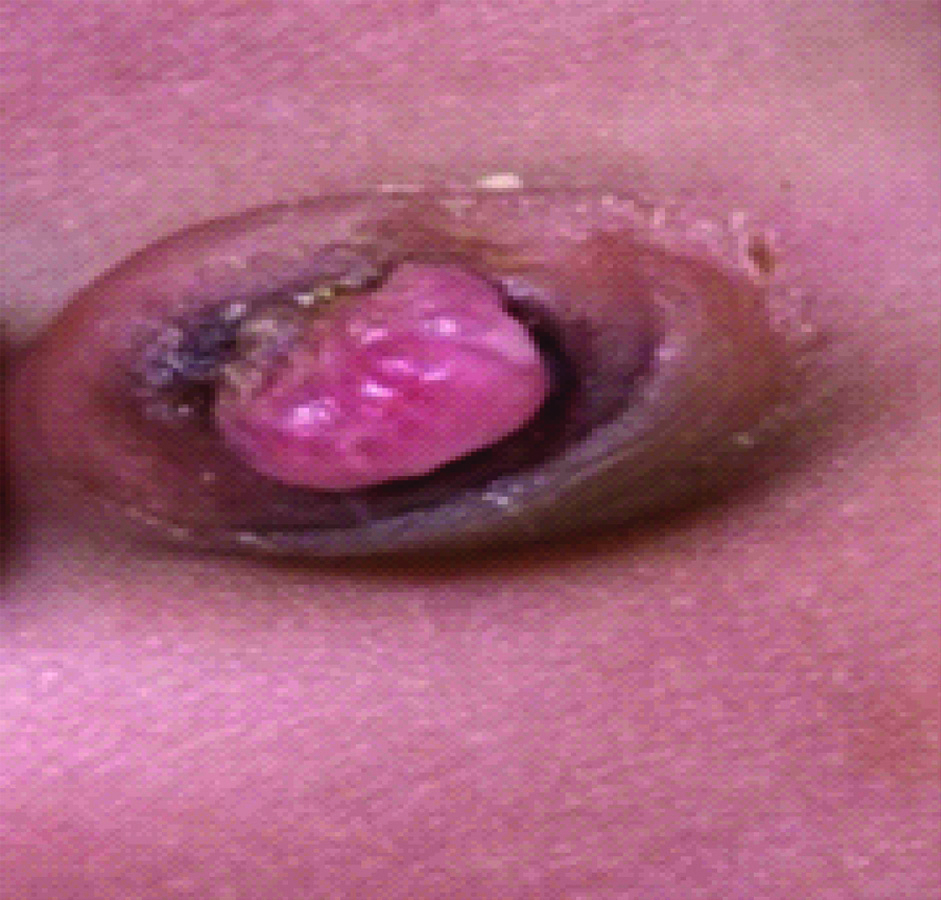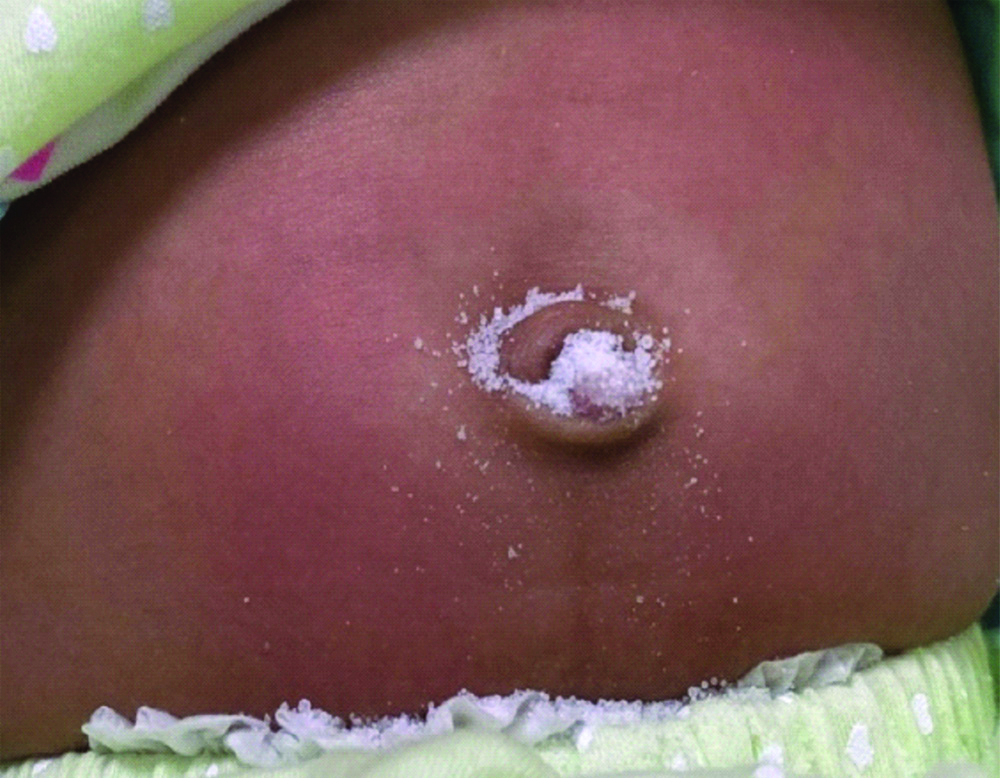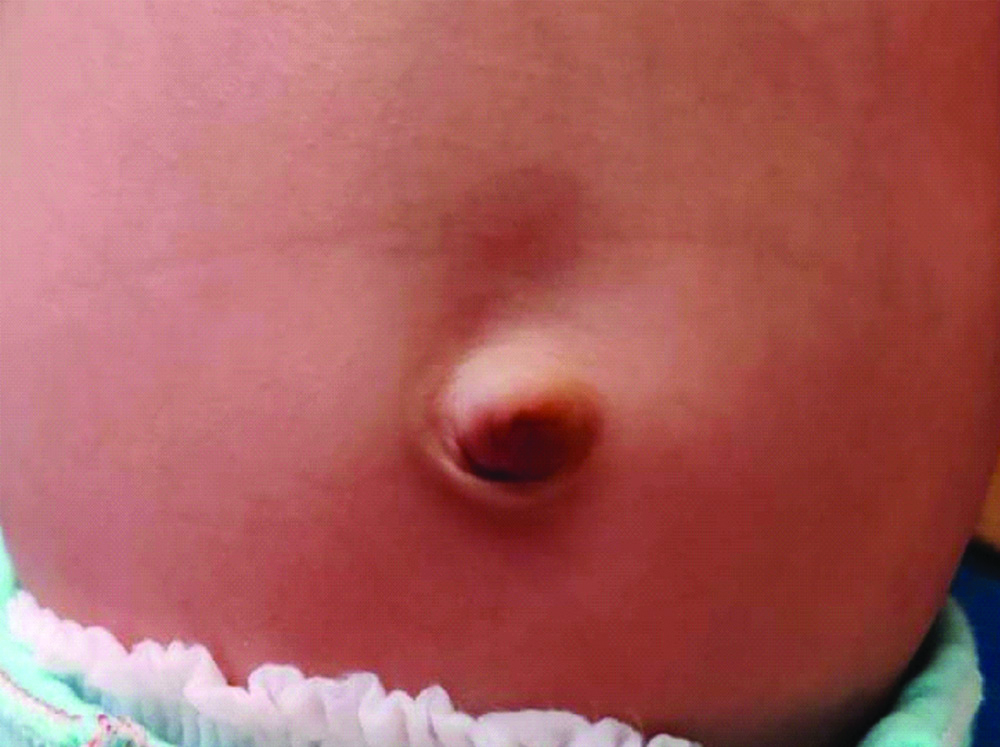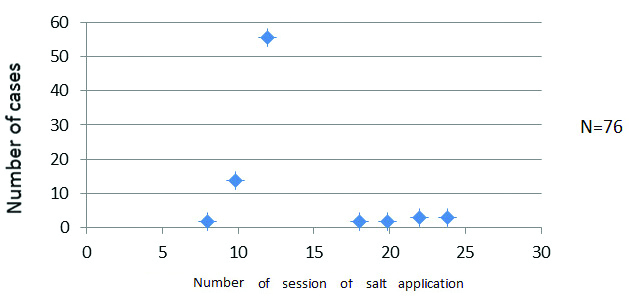Common Salt, An Effective Remedy for Management of Umbilical Granuloma- An Observational Study
Eti Sthapak1, Vijai Datta Upadhyaya2, Basant Kumar3, Anita Singh4, Akash Pandiata5, Kirti Narngane6
1 Assistant Professor, Department of Anatomy, RMLIMS, Lucknow, Uttar Pradesh, India.
2 Additional Professor, Department of Paediatric Surgery, SGPGIMS, Lucknow, Uttar Pradesh, India.
3 Additional Professor, Department of Paediatric Surgery, SGPGIMS, Lucknow, Uttar Pradesh, India.
4 Associate Professor, Department of Neonatology, SGPGIMS, Lucknow, Uttar Pradesh, India.
5 Assistant Professor, Department of Neonatology, SGPGIMS, Lucknow, Uttar Pradesh, India.
6 Associate Professor, Department of Neonatology, SGPGIMS, Lucknow, Uttar Pradesh, India.
NAME, ADDRESS, E-MAIL ID OF THE CORRESPONDING AUTHOR: Vijai Datta Upadhyaya, Department of Paediatric Surgery, SGPGIMS, Lucknow, Uttar Pradesh, India.
E-mail: upadhyayavj@rediffmail.com
Introduction
Usually, the residual umbilical stump separates by 7-15 days postpartum and the umbilical ring closes with epithelisation. In few infants, the umbilicus ring does not get epithealialised completely it forms an umbilical polyp and disappears in 2-3 weeks. Umbilical polyp requires medical attention if it persists beyond 3 weeks. Application of common salt for management of umbilical granuloma is one of the known modality of treatment owing to its hygroscopic action, though literature is sparse on the topic.
Aim
To observe the effect of common salt on umbilical granuloma.
Materials and Methods
Common salt application for management of umbilical granuloma is a standard modality at the study Institute. This was a retrospective observational study from January 2015 to December 2018. All data on infants of diagnosed umbilical granuloma, managed with application of salt, were evaluated. A total of 76 cases were managed during this period. Detailed demographic and clinical data was retrieved and collected in structured proforma from the electronic and manual record system. Descriptive statistical analysis was done.
Results
In all cases, the granuloma healed within a span of two weeks. Number of salt application ranged from 8 to 24 applications. Total time for which salt remained in contact of umbilicus ranged from 8 to 24 hours. The number of sessions of salt application from presentation of patient to cure ranged from 8 to 24; median for sessions of salt application for complete cure was 12. Median for 25 quartile and 75 quartile was 12. Parents did not report any behavioural changes, sleep disturbances, or irritability in the infants after the application. No other complication or recurrence was noted in follow-up of 1 year.
Conclusion
Common salt can be an effective modality to treat umbilical granuloma.
Chemical cauterisation,Persistent discharge,Umbilical polyp
Introduction
Usually umbilical stump separates by 7-15 days postpartum and range from 3 days to 2 months [1,2]. Once umbilical stump falls off the umbilical ring closed with epithelisation [3,4]. In few infants umbilical granuloma is seen; which looks like as a small piece of pink to bright red, moist flesh remaining in the umbilicus. If not treated granuloma persists for a long time because spontaneous resolution has not been documented in the literature [5].
Histologically, it is a granulation tissue composed of fibroblasts and capillaries and contains no nerves and hence is devoid of any sensation. The cause of umbilical granuloma is still debatable and spontaneous resolution of this condition had not been documented in the literature, hence proper treatment is needed once it persists beyond 2nd to 3rd week. It demands treatment because of continuous oozing of watery discharge and potential risk of infection [5].
Various treatment modalities for umbilical-granuloma are: chemical cauterisation, electrocauterisation, cryocauterisation, suture ligation and surgical excision. Though all modalities of treatment had curative effect but each method has its own advantage and disadvantage.
Cryo-cauterisation is an expensive and complex procedure with high failure rate and usually associated with foul smell [6]. Suture ligation is surgical intervention where suture is placed on the pedicle of the granuloma hence, is mainly used for granuloma with adequate pedicle. Results of this procedure are good but it is not effective if suture is not placed properly and may require sedation for proper placement of suture [7]. Surgical removal is reserved for larger granuloma or those with failed noninvasive management [3] but this procedure requires general anaesthesia [1].
Noninvasive management like chemical cauterisation is the most commonly used modality to treat umbilical granuloma and agents used are; silver nitrate sticks [8,9], copper sulphate granules [10,11], ethanol wipes [12] and clobestasol proponiate [13] and more recently common salt is gaining popularity.
Use of conventional 75% silver nitrate sticks may require repeat application and can cause chemical burns to the surrounding normal skin [8,9]. Same drawbacks are know with application of copper sulpahte granules [10,11]. Results of clobetasol propionate application were convincing and were found to be equivalent to silver nitrate [13]. Though, its application is safe and done by parents at home but it needs a time frame of 30 days and even use of a topical steroid which carries a potential risk of local and systemic side effects [14]. Advantage of using ethanol wipes is that it can be used by parents at home safely but results ranged from 53% (13) to 67% [13] though it is safely used by parents at home.
In search of safer and effective management of umbilical granuloma, common salt was used by few researchers [15,16], considering the fact that granuloma does not have free nerve ending and salt has a property of desiccation. The high concentration of sodium ion in the area draws water out of the cells and results in shrinkage and necrosis of the wet granulation tissue.
Application of common salt for treating umbilical granuloma has been tried in past and used at some centres in India [16,17]. This retrospective observational study was carried to know the efficacy of common salt/table salt (rock salt) in the management of umbilical granuloma.
Materials and Methods
This was a retrospective study performed at Paediatric Surgery Outpatient Clinic, tertiary centre in North India from January 2015 to December 2018. As per the record, a total of 85 infants presented to Paediatric Surgery OPD of which only 76 were managed with salt application because, 5 patients already received some treatment from general practitioner, 2 had periumbilical infection, and one infant had suspicion of urachal remnant and in one case parent opted for surgical intervention.
The steps of the procedure which was followed for management of umbilical granuloma as per the hospital protocol were: (i) Lesion was cleaned with cotton ball soaked in warm water [Table/Fig-1]; ii) Pinch of common salt was sprinkled properly over the lesion so that lesion was well covered by the salt [Table/Fig-2]; iii) Lesion left as such for one hour and then cleaned with water soaked cotton; iv) This procedure was explained to parents and they repeated same procedure twice daily for 6 days or less if granuloma is dried and to review on day 8 [Table/Fig-3].
Showing umbilical granuloma.

Showing application of salt on the lesion.

After 12 application of salt on the lesion.

As per the records, the patients were reviewed in outpatient department after one week of first session of salt application. The data were categorised for the sake of analysis into:
a) Cured: Granuloma was separated completely displaying normal skin cover and without any serous discharge;
b) Partial response: Granuloma persistent after one week of salt application without discharge;
c) Non responsive: No change in the nature of the disease.
Patients with partial response as well as patients who were in non responsive category were asked to repeat same procedure for next 6 days. If granuloma or discharge persist even after 2 weeks it was considered as non responsive or not cured.
Following parameters were retrieved from the record at each visit: 1) Change in colour of lesion; 2) change in size of the lesion; 3) soakage if any from the lesion; 4) excessive crying during salt application; 5) behavioural changes; 6) sleep disturbance; and 7) any skin change. Parents did not report any behavioural changes, sleep disturbances, or irritability in the infants after the application.
Statistical Analysis
Data was entered in MS excel and scrutinised for error. Further, categorical variable were expressed in frequency and percentage. Association of categorical variable was assessed by Chi-square/Fisher-Exact test. The p-value less than 0.05 was considered as statistically significant and analysed by Stata 14 (Stata Corp, College Station, Texas).
Results
A total of 76 patients umbilical granuloma, aged between 4 weeks to 20 weeks were managed during January 2015 to December 2018 [Table/Fig-4]. In 69 infants the granuloma separated within one week whereas in rest 7 cases it took 8 to 14 days. None of the patients required excision or alternative treatment. None of the patients had complaint of excessive cry or any change in skin colour during the course of salt application. All parents continued the treatment without difficulty and umbilicus returned to normal in all cases with in span of two weeks.
| Age in weeks at time of presentation | Male (%) | Female (%) | p-value |
|---|
| 4-10 weeks | 22 (56.4) | 16 (43.2) | 0.463 |
| 11-15 weeks | 11 (28.1) | 12 (32.4) |
| >15 weeks | 6 (15.6) | 9 (24.4) |
Chi-square test
All patients that presented at age of 4-10 weeks had full recovery within 7 days where as those presented after 15 weeks had partial response after one week of treatment; complete resolution was observed after 2 weeks of treatment and was statistically significant [Table/Fig-5].
Response in patients presenting in different age group.
| Age | Complete response in one week (%) | Complete response in 2 weeks (%) | No complete response (failed treatment) | p-value |
|---|
| 4-15 weeks | 60 (98.3) | 1 (1.7) | None | 0.001 |
| >15 weeks | 9 (64.3) | 6 (35.7) | None |
Fisher-Exact test applied
Number of salt application ranged from 8 to 24 applications. Total time for which salt remained in contact of umbilicus ranged from 8 to 24 hours. The number of sessions of salt application from presentation of patient to cure ranged from 8 to 24 [Table/Fig-6] and median for sessions of salt application for complete cure was 12. Median for 25 quartile and 75 quartile was 12.
Showing frequency of salt application.
X axis showing the number of sessions of salt application and Y axis showing number of cases

Parents did not report any behavioural changes, sleep disturbances, or irritability in the infants after the application. No other complication or recurrence was noted in follow-up of 1 year. Frequency of 12 application were highest in cases included in the study for cure that mean; most patients required 12 sessions of salt application for cure of the lesion and the contact time of salt with skin was around 12 hours for most of the cases [Table/Fig-6].
Discussion
Umbilical granuloma is a minor condition with no recognised associated anomalies and is effectively and easily managed by local application of common salt. Other umbilical conditions may present in a similar manner and be difficult to distinguish and may not be cured with salt application. Therefore, adequate assessing of the discharge and swelling of the umbilicus is important in order to minimise diagnostic errors and delays in the initiation of the correct treatment.
The exact steps for method of salt application: i) Cleaning of umbilical area with a wet cotton pad; ii) Pinch of salt crystals is sprinkled on the granuloma; iii) Granuloma is closed with an adhesive drape; iv) Drape is opened 30 minutes after the procedure and the application procedure is terminated;v) This process is repeated 3 times a day for 3 consecutive days [15]. The method was modified by different authors for better results. In present study method of application was taught to the parent of patients to avoid frequent visit to the hospital. The lesion was not covered with adhesive tape because if adhesive tape is left for long time by mistake it can lead to skin changes due to sogginess. In almost all studies application of salt (session) was not done for more than 5-7 days; in present study number of days and hence, number of session were increased to get better results. In present study the duration of salt exposure was increased by increasing the session of salt application owing to the fact the that salt does not produce any harmful effect on skin.
On review of English literature, application of salt for management of umbilical granuloma was known since 1972 [16], when Schmitt BD described the shrinking effect of common salt on umbilical granuloma.
Kesaree N et al., observed 100% cure with application of common salt for duration of only 10-15 minutes daily for 3 consecutive days [17]. Efficacy of salt on umbilical granuloma ranged from 53% to 100% in different studies [18-22]. The protocol of salt application was modified by Al Saleh AS and Tripathi RK et al., by increasing exposure time of common salt to the granuloma, either by increasing the duration of each application or by increasing the number of application to increase the efficacy [18,19]. Response rate of salt application in different studies as summarised in [Table/Fig-7] [10,11,18-22]. It was observed that patients presenting early required less number of applications of salt than those who presented late contrary to the result of Al Saleh AS who found no change in response rate according to age of presentation [18].
Comparisons of different studies [10,11,18-22].
| Study | Response at 1 week | Duration of application of salt |
|---|
| Hossain AZ et al., 2010 [20] | 44/48 | Twice a day for 30 minutes for 3 consecutive days |
| Annapurna D et al., 2015 [11] | 22/40 | Twice a day for 30 minutes each session for 3 days |
| Al Saleh AS et al., 2016 [18] | 50/50 | Twice a day for 30 minutes each session and for 5 days |
| Fiaz M et al., 2017 [10] | 16/30 | Twice a days for 30 minutes for 3 consecutive days |
| Tripathi RK et al., 2018 [19] | 121/126 | Twice a day for one hours each session for 7 days |
| Dhungel S et al., 2018 [22] | 171/180 | Twice a day for 1 hours for 3 consecutive days |
| Bagadia J et al., 2019 [21] | 17/17 | One application which persist for 24 hours# |
| Present study* | 69/76 | Twice a day for 6 days for 1 hour** |
*Salt application done ranging from 5 days to 12 days +: all 7 showed after 2nd week** in few patient granuloma healed in five days hence duration of salt application is only for five days; $Salt application done for three consecutive days and evaluated after one week and three weeks of last application; #salt application only once and area is covered with bandage and reviewed after 24 hours. Observed microvesiculation observed in two cases^: after salt application lesion was covered with adhesive tape
Limitation(s)
It was a retrospective study and there was no comparison with any other mode of treatment. Number of session and duration of salt application calculation was subjective, because it was assumed that the parent will apply the salt strictly to the time and method demonstrated to them the result assessment was subjective because parents were advised not to apply salt if lesion was properly shrinked.
Conclusion(s)
Common salt can be an effective, safe and comparatively cheaper home remedy for management of umbilical.
Chi-square testFisher-Exact test applied*Salt application done ranging from 5 days to 12 days +: all 7 showed after 2nd week** in few patient granuloma healed in five days hence duration of salt application is only for five days; $Salt application done for three consecutive days and evaluated after one week and three weeks of last application; #salt application only once and area is covered with bandage and reviewed after 24 hours. Observed microvesiculation observed in two cases^: after salt application lesion was covered with adhesive tape
[1]. Pomeranz A, Anomalies, abnormalities, and care of the umbilicus Pediatr Clin North Am 2004 51(3):819-27.10.1016/j.pcl.2004.01.01015157600 [Google Scholar] [CrossRef] [PubMed]
[2]. Wilson CB, Ochs HD, Almquist J, Dassel S, Mauseth R, Ochs UH, When is umbilical cord separation delayed? J Pediatr 1985 107(2):292-94.10.1016/S0022-3476(85)80154-2 [Google Scholar] [CrossRef]
[3]. Nagar H, Umbilical granuloma: A new approach to an old problem Pediatr Surg Int 2001 17:513-14.10.1007/s00383010058411666047 [Google Scholar] [CrossRef] [PubMed]
[4]. Badebarin D, AslanAbadi S, Shakeri MM, Jamshidi M, KarkonShayan F, A comparison between the clinical results of salt therapy and surgery in the treatment of umbilical granuloma in infants Iranian Journal of Pediatric Surgery 2018 4(1):07-13. [Google Scholar]
[5]. Snyder CL, Current management of umbilical abnormalities and related anomalies Semin Pediatr Surg 2007 16(1):41-49.10.1053/j.sempedsurg.2006.10.00617210482 [Google Scholar] [CrossRef] [PubMed]
[6]. Sheth SS, Malpani A, The management of umbilical granulomas with cryocautery Indian J Pediatr 1981 18:909-12. [Google Scholar]
[7]. Lotan G, Klin B, Efrati Y, Double-ligature: A treatment for pedunculated umbilical granulomas in children Am Fam Physician 2002 65(10):2067-68. [Google Scholar]
[8]. Majjiga V, Kumaresan P, Glass E, Silver nitrate burns following umbilical granuloma treatment Arch Dis Child 2005 90(7):67410.1136/adc.2004.06791815970607 [Google Scholar] [CrossRef] [PubMed]
[9]. Ogawa C, Sato Y, Suzuki C, Mano A, Tashiro A, Niwa T, Treatment with silver nitrate versus topical steroid treatment for umbilical granuloma: A non-inferiority randomized control trial PLoS One 2019 14(6):e021820510.1371/journal.pone.021820531185041 [Google Scholar] [CrossRef] [PubMed]
[10]. Fiaz M, Bhatti AB, Ahmed N, Ahmed RR, A Comparative study of the therapeutic effects of copper sulpate versus common salt (sodium chloride) in the treatment of infantile umbilical granuloma JMSCR 2017 5(11):31127-32.10.18535/jmscr/v5i11.226 [Google Scholar] [CrossRef]
[11]. Annapurna D, Ramu P, Therapeutic effect of copper sulphate vs common salt (table/cooking salt) on umbilical granuloma in infants: A comparative study Journal of Evolution of Medical and Dental Sciences 2015 4(10):1616-21. [Google Scholar]
[12]. Daniels J, Is silver nitrate the best agent for management of umbilical granulomas? Arch Dis Child 2001 85(5):432 [Google Scholar]
[13]. Brødsgaard A, Nielsen T, Mølgaard U, Pryds O, Pedersen P, Treating umbilical granuloma with topical clobetasol propionate cream at home is as effective as treating it with topical silver nitrate in the clinic Acta Paediatr 2015 104(2):174-77.10.1111/apa.1282425297721 [Google Scholar] [CrossRef] [PubMed]
[14]. Aydin M, Orman A, Deveci U, Taskin E, Topical clobetasol propionate may not be safe for treating umbilical granuloma in infants Acta Paediatr 2015 104(2):e4910.1111/apa.1284925366299 [Google Scholar] [CrossRef] [PubMed]
[15]. Karagüzel G, Aldemir H, Umbilical granuloma: Modern understanding of etiopathogenesis, diagnosis, and management J Pediatr Neonatal Care 2016 4(3):13610.15406/jpnc.2016.04.00136 [Google Scholar] [CrossRef]
[16]. Schmitt BD, Tip of the month, shrinking umbilical granulomas Consultant 1972 12:91 [Google Scholar]
[17]. Kesaree N, Babu PS, Banapurmath CR, Krishnamurthy SN, Umbilical granuloma Indian Pediatr 1983 20(9):690-92. [Google Scholar]
[18]. Al Saleh AS, Therapeutic effect of common salt on umbilical granuloma in infants Int J Med Sci Public Health 2016 5(5):911-14.10.5455/ijmsph.2016.07012016312 [Google Scholar] [CrossRef]
[19]. Tripathi RK, Debnath PR, Shah S, Tripathi D, Debnath E, Therapeutic effect of table salt on umbilical granuloma in infants-North Indian experience Int J Med Paediatr Oncol 2018 4(2):77-79.10.18231/2581-4702.2018.0017 [Google Scholar] [CrossRef]
[20]. Hossain AZ, Hasan GZ, Islam KD, Therapeutic effect of common salt (table/cooking salt) on umbilical granuloma in infants Bangladesh J. Child Health 2010 34(3):99-102.10.3329/bjch.v34i3.10360 [Google Scholar] [CrossRef]
[21]. Bagadia J, Jaiswal S, Bhalala KB, Poojary S, Pinch of salt: A modified technique to treat umbilical granuloma Pediatr Dermatol 2019 36:561-63.10.1111/pde.1385131120144 [Google Scholar] [CrossRef] [PubMed]
[22]. Dhungel S, Pokhrel A, Acharya A, EC Paediatrics outcomes and cost analysis of salt therapy versus silver nitrate for treatment of umbilical granuloma: 4-years Experience in a Private Health Centre 2018 7(7):653-59. [Google Scholar]